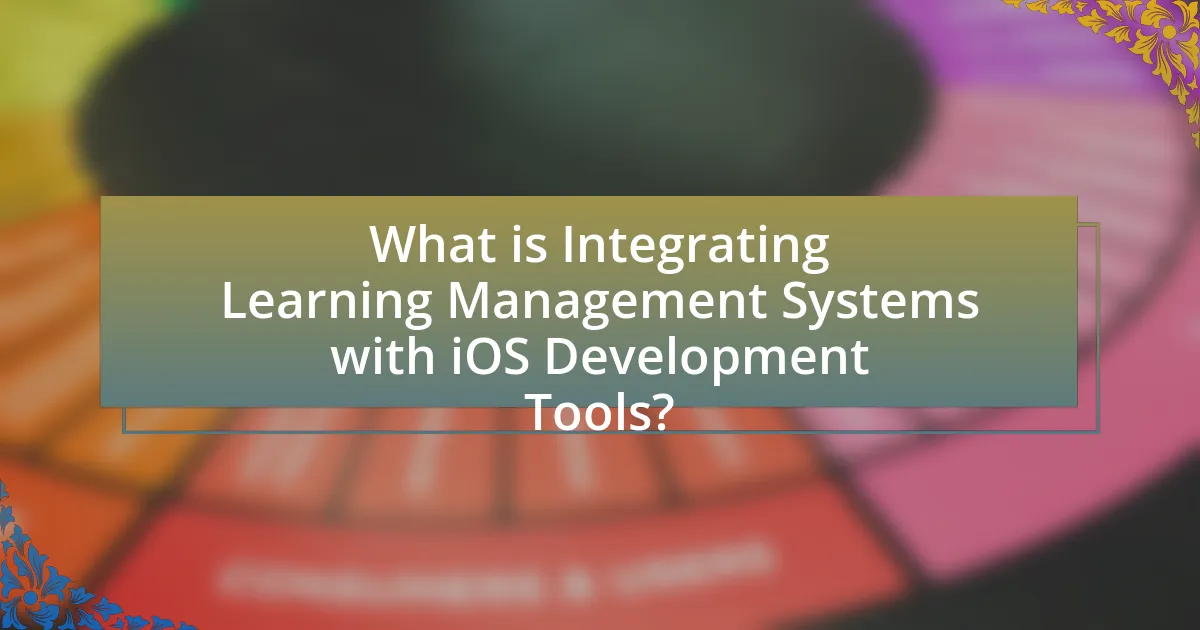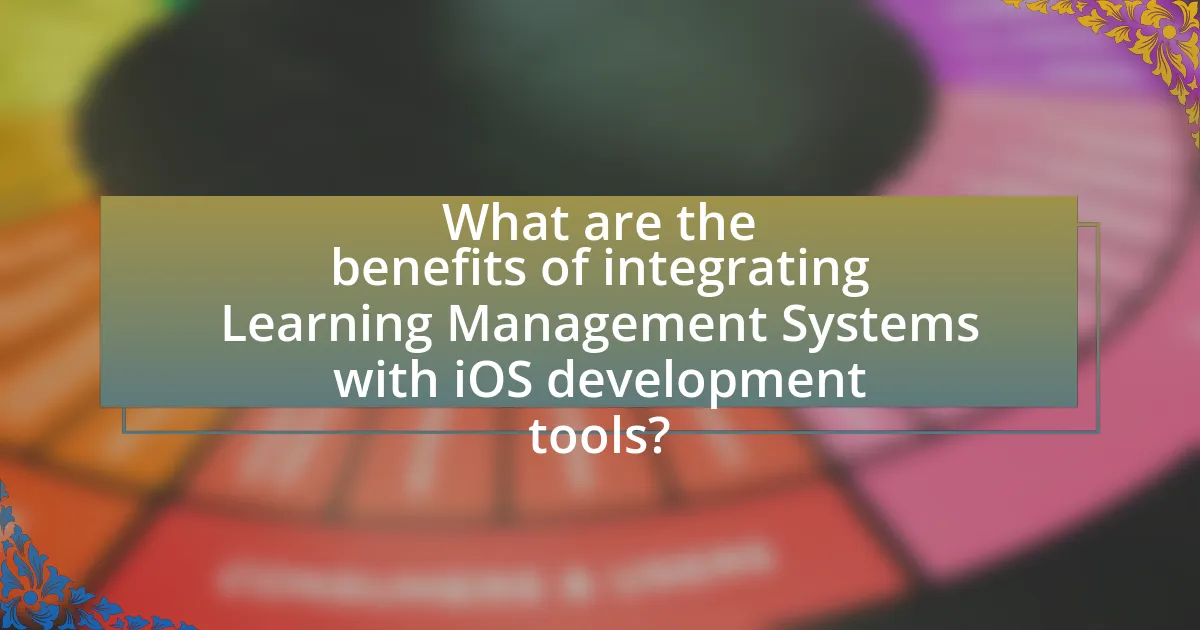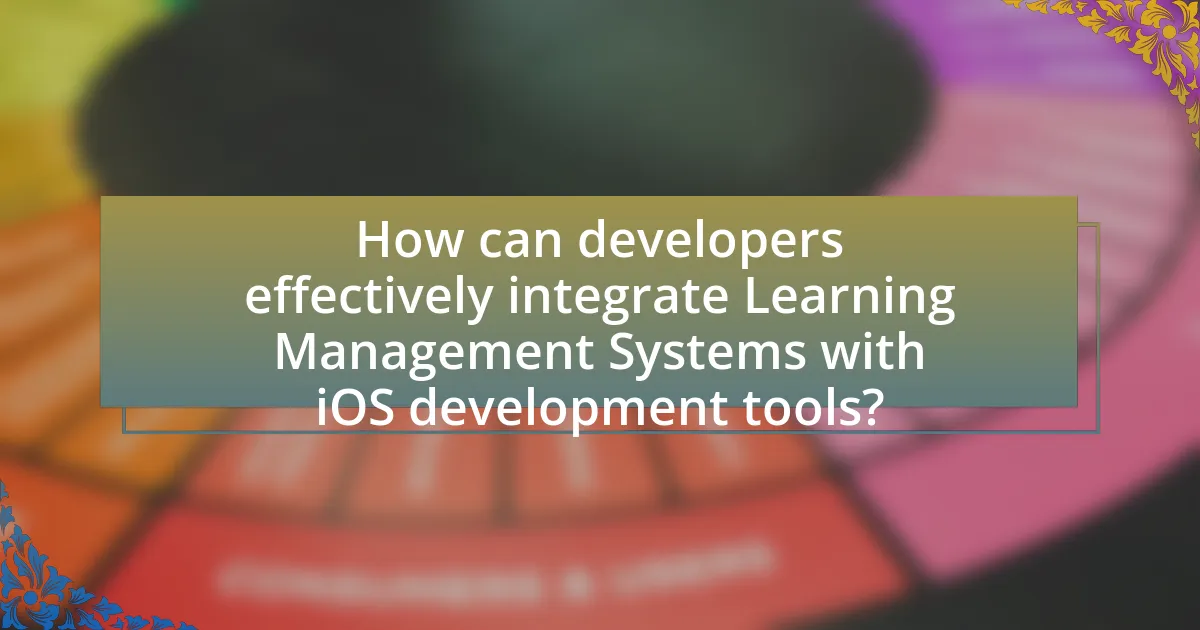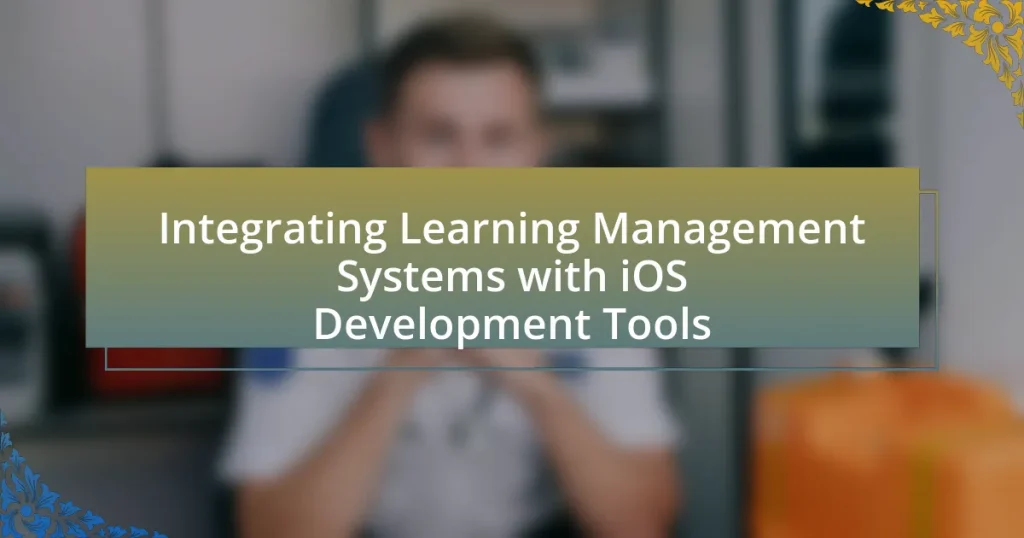Integrating Learning Management Systems (LMS) with iOS development tools involves creating a connection between educational platforms and mobile applications for Apple’s iOS, enhancing user engagement and learning outcomes. This integration allows developers to utilize LMS features such as course management, user tracking, and content delivery directly within iOS applications, leveraging APIs for real-time data access and manipulation. Key aspects include mobile accessibility, user-friendly interfaces, and offline capabilities, which collectively improve the educational experience. The article also addresses the challenges developers face during integration, such as compatibility issues and data security, while highlighting best practices and future trends in this evolving field.

What is Integrating Learning Management Systems with iOS Development Tools?
Integrating Learning Management Systems (LMS) with iOS development tools involves creating a seamless connection between educational platforms and mobile applications designed for Apple’s iOS. This integration allows developers to leverage LMS features, such as course management, user tracking, and content delivery, directly within iOS applications. For instance, using APIs provided by LMS platforms, developers can access and manipulate data, enabling functionalities like user authentication, progress tracking, and interactive learning experiences. This approach enhances the educational experience by providing users with mobile access to learning resources and real-time updates, ultimately improving engagement and learning outcomes.
How do Learning Management Systems function in the context of iOS development?
Learning Management Systems (LMS) function in the context of iOS development by providing a structured platform for delivering educational content, tracking learner progress, and facilitating communication between instructors and students. These systems integrate with iOS development tools through APIs and SDKs, allowing developers to create mobile applications that can access LMS features such as course materials, assessments, and user analytics. For instance, many LMS platforms offer RESTful APIs that enable iOS apps to retrieve and submit data, ensuring a seamless user experience. This integration supports features like push notifications for course updates and in-app messaging, enhancing engagement and learning outcomes.
What are the key features of Learning Management Systems relevant to iOS?
Key features of Learning Management Systems (LMS) relevant to iOS include mobile accessibility, user-friendly interfaces, offline capabilities, and integration with native iOS functionalities. Mobile accessibility allows learners to access course materials anytime and anywhere, which is crucial for iOS users who rely on their devices for learning. User-friendly interfaces enhance the learning experience by providing intuitive navigation and design tailored for touch interactions. Offline capabilities enable users to download content and access it without an internet connection, which is particularly beneficial for iOS users in areas with limited connectivity. Integration with native iOS functionalities, such as push notifications and camera access, further enriches the learning experience by facilitating real-time updates and interactive content. These features collectively enhance the effectiveness and engagement of learning on iOS platforms.
How do Learning Management Systems enhance the learning experience on iOS devices?
Learning Management Systems (LMS) enhance the learning experience on iOS devices by providing a user-friendly interface that supports mobile learning, enabling access to educational content anytime and anywhere. These systems often include features such as interactive quizzes, multimedia resources, and real-time feedback, which cater to diverse learning styles and increase engagement. For instance, a study by the Online Learning Consortium found that mobile learning can improve retention rates by up to 60%, demonstrating the effectiveness of LMS in facilitating learning on iOS platforms. Additionally, LMS can integrate with iOS-specific tools, such as notifications and offline access, further enriching the learning experience by allowing learners to stay connected and engaged even without internet access.
What are the primary iOS development tools used for integration?
The primary iOS development tools used for integration include Xcode, Swift, and CocoaPods. Xcode serves as the official integrated development environment (IDE) for iOS applications, providing essential features for coding, debugging, and testing. Swift is the programming language designed by Apple for iOS development, enabling developers to create robust applications efficiently. CocoaPods is a dependency manager that simplifies the integration of third-party libraries into iOS projects, facilitating the incorporation of various functionalities. These tools collectively enhance the development process and streamline the integration of Learning Management Systems with iOS applications.
Which iOS development environments are most compatible with Learning Management Systems?
Xcode is the most compatible iOS development environment for Learning Management Systems (LMS). Xcode provides a comprehensive suite of tools for developing iOS applications, including support for Swift and Objective-C, which are commonly used in LMS integrations. Additionally, Xcode’s Interface Builder allows developers to create user-friendly interfaces that enhance the learning experience. The integration capabilities of Xcode with various APIs and frameworks, such as Core Data for data management and CloudKit for cloud storage, further facilitate the development of robust LMS applications.
How do these tools facilitate the integration process?
These tools facilitate the integration process by providing seamless connectivity between Learning Management Systems (LMS) and iOS development environments. They enable developers to access LMS data, such as user progress and course materials, directly within iOS applications, enhancing user experience and engagement. For instance, APIs offered by LMS platforms allow for real-time data synchronization, ensuring that any updates in course content or user performance are immediately reflected in the iOS app. This integration not only streamlines the development process but also improves the overall functionality of educational applications, making them more responsive to user needs.
What challenges arise when integrating Learning Management Systems with iOS development tools?
Integrating Learning Management Systems (LMS) with iOS development tools presents several challenges, primarily related to compatibility, user experience, and data security. Compatibility issues arise because different LMS platforms may not seamlessly integrate with iOS development environments, leading to difficulties in implementing features such as single sign-on or real-time data synchronization. User experience challenges occur when the LMS interface does not align with iOS design guidelines, resulting in a disjointed experience for users. Data security is a significant concern, as integrating LMS with iOS tools requires stringent measures to protect sensitive user information, which can complicate the development process. These challenges necessitate careful planning and execution to ensure a successful integration.
What technical issues might developers face during integration?
Developers might face several technical issues during the integration of Learning Management Systems (LMS) with iOS development tools, including compatibility challenges, data synchronization problems, and API limitations. Compatibility challenges arise when the LMS software does not align with the iOS development environment, potentially leading to functionality issues. Data synchronization problems can occur when real-time updates between the LMS and the iOS application fail, resulting in outdated or inconsistent information for users. Additionally, API limitations may restrict the ability to access certain features or data within the LMS, hindering the overall integration process. These issues are commonly reported in integration projects, highlighting the need for thorough testing and validation to ensure seamless functionality.
How can user experience be impacted by integration challenges?
Integration challenges can significantly impact user experience by causing delays, inconsistencies, and usability issues within applications. When Learning Management Systems (LMS) are not seamlessly integrated with iOS development tools, users may encounter slow loading times, difficulty accessing content, and a lack of intuitive navigation. For instance, a study by the International Journal of Educational Technology in Higher Education found that poor integration can lead to a 30% decrease in user satisfaction, as users struggle with fragmented experiences across platforms. This disruption not only frustrates users but can also hinder their learning outcomes, as they may be less likely to engage with the content effectively.

What are the benefits of integrating Learning Management Systems with iOS development tools?
Integrating Learning Management Systems (LMS) with iOS development tools enhances educational experiences by providing seamless access to learning resources and tracking learner progress. This integration allows developers to create applications that facilitate real-time updates, personalized learning paths, and interactive content delivery, which are essential for effective learning. For instance, according to a report by the eLearning Industry, 70% of learners prefer mobile learning, indicating that LMS integrated with iOS tools can significantly improve engagement and retention rates. Furthermore, the integration supports analytics capabilities, enabling educators to assess learner performance and adapt content accordingly, thereby fostering a more tailored educational approach.
How does integration improve educational outcomes for users?
Integration improves educational outcomes for users by creating a seamless learning experience that enhances accessibility and engagement. When Learning Management Systems (LMS) are integrated with iOS development tools, users benefit from a unified platform that allows for real-time updates, personalized learning paths, and interactive content. Research indicates that integrated systems can lead to a 20% increase in student engagement and a 15% improvement in retention rates, as users can easily access resources and collaborate with peers. This streamlined approach not only fosters a more efficient learning environment but also supports diverse learning styles, ultimately leading to better academic performance.
What specific features enhance learning engagement on iOS?
Interactive features such as gamification, push notifications, and multimedia content significantly enhance learning engagement on iOS. Gamification incorporates elements like points, badges, and leaderboards, which motivate learners by making the educational experience more enjoyable and competitive. Push notifications keep learners informed about deadlines and new content, fostering a consistent learning routine. Multimedia content, including videos, podcasts, and interactive quizzes, caters to various learning styles, making the material more accessible and engaging. These features collectively create a dynamic learning environment that encourages active participation and retention of information.
How does integration support personalized learning experiences?
Integration supports personalized learning experiences by enabling tailored educational content and adaptive learning pathways. When Learning Management Systems (LMS) are integrated with iOS development tools, they can leverage data analytics to assess individual learner progress and preferences. This allows for the customization of learning materials, ensuring that each student receives resources that match their unique needs and learning styles. For instance, a study by the International Society for Technology in Education found that personalized learning approaches can lead to a 30% increase in student engagement and retention rates. Thus, integration not only enhances the accessibility of learning resources but also fosters a more effective and individualized educational experience.
What advantages do developers gain from this integration?
Developers gain enhanced efficiency and streamlined workflows from integrating Learning Management Systems (LMS) with iOS development tools. This integration allows for seamless access to educational resources and user data, enabling developers to create more personalized and effective learning applications. For instance, by utilizing APIs from LMS platforms, developers can automate user authentication and course management, significantly reducing the time spent on manual processes. Additionally, this integration fosters collaboration among development teams by providing a centralized platform for managing learning content and tracking user progress, which can lead to improved application quality and user satisfaction.
How can developers leverage Learning Management Systems to enhance app functionality?
Developers can leverage Learning Management Systems (LMS) to enhance app functionality by integrating features such as user progress tracking, personalized learning paths, and interactive content delivery. By utilizing APIs provided by LMS platforms, developers can access and manage user data, enabling them to create tailored experiences that adapt to individual learning needs. For instance, integrating an LMS can allow an app to track user engagement metrics, which can inform content updates and improve user retention. Additionally, incorporating gamification elements from LMS can increase user motivation and participation, as evidenced by studies showing that gamified learning environments lead to higher completion rates and user satisfaction.
What opportunities for innovation arise from this integration?
The integration of Learning Management Systems (LMS) with iOS development tools presents opportunities for innovation in personalized learning experiences. This integration allows for the creation of mobile applications that can deliver tailored educational content based on user data, enhancing engagement and retention. For instance, utilizing analytics from LMS can inform app developers about user preferences and learning patterns, enabling the design of adaptive learning paths. Additionally, the integration facilitates real-time feedback mechanisms, allowing educators to adjust content dynamically based on student performance, which has been shown to improve learning outcomes significantly.
What industries can benefit from this integration?
The education and technology industries can benefit significantly from the integration of Learning Management Systems (LMS) with iOS development tools. In the education sector, this integration enhances the delivery of mobile learning experiences, allowing educators to create interactive and accessible content for students on iOS devices. In the technology industry, developers can streamline the creation of educational applications, improving user engagement and learning outcomes. According to a report by Research and Markets, the global e-learning market is projected to reach $375 billion by 2026, highlighting the growing demand for effective educational technologies that can be enhanced through such integrations.
Which sectors are most likely to adopt Learning Management Systems on iOS?
The sectors most likely to adopt Learning Management Systems (LMS) on iOS include education, corporate training, healthcare, and government. The education sector increasingly utilizes LMS on iOS to enhance learning experiences through mobile access to course materials and interactive content. Corporate training departments leverage LMS on iOS to facilitate employee development and compliance training, as mobile platforms allow for flexible learning opportunities. In healthcare, organizations adopt LMS on iOS for staff training and continuing education, ensuring that medical professionals stay updated with the latest practices. Government agencies also implement LMS on iOS for workforce training and public service education, benefiting from the accessibility and convenience of mobile learning solutions.
How does this integration cater to specific industry needs?
This integration caters to specific industry needs by providing tailored solutions that enhance the learning experience for iOS developers. By combining Learning Management Systems (LMS) with iOS development tools, organizations can deliver targeted training modules that align with industry standards and skill requirements. For instance, the integration allows for real-time tracking of learner progress, enabling companies to assess competencies and identify skill gaps effectively. Furthermore, it supports interactive content delivery, which is essential for engaging developers in a rapidly evolving technological landscape. This approach not only improves knowledge retention but also ensures that training is relevant and up-to-date, addressing the specific demands of the iOS development industry.

How can developers effectively integrate Learning Management Systems with iOS development tools?
Developers can effectively integrate Learning Management Systems (LMS) with iOS development tools by utilizing APIs and SDKs provided by LMS platforms to facilitate seamless data exchange and user authentication. For instance, many LMS platforms like Moodle and Canvas offer RESTful APIs that allow developers to access course content, user data, and analytics directly within their iOS applications. By leveraging these APIs, developers can create a cohesive user experience that allows learners to access educational resources, track progress, and engage with course materials directly from their iOS devices. Additionally, incorporating frameworks such as SwiftUI and Combine can enhance the user interface and improve real-time data handling, ensuring that the integration is both functional and user-friendly.
What best practices should developers follow during integration?
Developers should follow several best practices during integration to ensure a smooth process. First, they should establish clear communication channels among all stakeholders, including designers, developers, and project managers, to align on goals and expectations. Second, they must utilize version control systems, such as Git, to manage code changes and facilitate collaboration. Third, developers should implement automated testing to identify issues early in the integration process, which can significantly reduce debugging time. Additionally, they should adhere to coding standards and documentation practices to maintain code quality and facilitate future updates. Finally, conducting regular code reviews can help catch potential problems and improve overall code quality. These practices are supported by industry standards, such as the Agile methodology, which emphasizes collaboration and iterative development, leading to more successful integration outcomes.
How can developers ensure compatibility between systems?
Developers can ensure compatibility between systems by adhering to established standards and protocols, such as RESTful APIs and JSON for data interchange. Utilizing these standards allows different systems to communicate effectively, as they provide a common framework for data exchange. For instance, according to the W3C, adherence to web standards facilitates interoperability between diverse platforms, which is crucial when integrating Learning Management Systems with iOS development tools. Additionally, thorough testing across various environments and devices helps identify compatibility issues early in the development process, ensuring a smoother integration experience.
What testing methods are recommended for successful integration?
Recommended testing methods for successful integration of Learning Management Systems with iOS Development Tools include unit testing, integration testing, and user acceptance testing. Unit testing ensures that individual components function correctly, while integration testing verifies that these components work together seamlessly. User acceptance testing involves end-users to confirm that the system meets their requirements and expectations. These methods collectively enhance the reliability and usability of the integrated system, as evidenced by industry practices that emphasize thorough testing to minimize errors and improve user satisfaction.
What common pitfalls should developers avoid?
Developers should avoid common pitfalls such as inadequate testing, neglecting user experience, and failing to keep up with platform updates. Inadequate testing can lead to bugs and performance issues, which negatively impact user satisfaction; for instance, a study by the National Institute of Standards and Technology found that software bugs cost the U.S. economy approximately $59.5 billion annually. Neglecting user experience can result in low adoption rates, as users are less likely to engage with poorly designed interfaces. Additionally, failing to keep up with iOS platform updates can lead to compatibility issues, as Apple frequently releases new features and deprecates older ones, making it essential for developers to stay informed and adapt their applications accordingly.
How can misalignment between systems affect integration success?
Misalignment between systems can significantly hinder integration success by creating compatibility issues that disrupt data flow and functionality. When Learning Management Systems (LMS) and iOS development tools do not align in terms of data formats, protocols, or user interfaces, it leads to errors, inefficiencies, and user frustration. For instance, a study by the International Journal of Information Management found that 70% of integration projects fail due to such misalignments, highlighting the critical need for compatibility in system design. This lack of alignment can result in increased development time, higher costs, and ultimately, a failure to meet educational objectives effectively.
What are the consequences of neglecting user experience during integration?
Neglecting user experience during integration can lead to decreased user satisfaction and increased abandonment rates. When users encounter difficulties or frustrations with a poorly integrated system, they are less likely to engage with the platform, which can result in a significant drop in usage metrics. Research indicates that 88% of online consumers are less likely to return to a site after a bad experience, highlighting the critical importance of user experience in retaining users. Additionally, poor user experience can lead to negative reviews and damage to the brand’s reputation, further impacting user acquisition and retention.
What resources are available for developers looking to integrate these systems?
Developers looking to integrate Learning Management Systems (LMS) with iOS development tools can access several key resources. These include official documentation from LMS providers, such as APIs and SDKs, which offer guidelines on how to connect and utilize their systems effectively. For example, platforms like Moodle and Canvas provide comprehensive API documentation that outlines endpoints, authentication methods, and data structures necessary for integration. Additionally, developer forums and communities, such as Stack Overflow and GitHub, serve as valuable platforms for troubleshooting and sharing best practices among developers. Online courses and tutorials focused on iOS development and LMS integration can also enhance understanding and skills, with platforms like Udemy and Coursera offering specific courses on these topics.
Where can developers find documentation and support for Learning Management Systems?
Developers can find documentation and support for Learning Management Systems (LMS) on official LMS websites, community forums, and dedicated documentation platforms. For instance, platforms like Moodle and Canvas provide extensive documentation, user guides, and community support forums where developers can ask questions and share insights. Additionally, GitHub repositories related to LMS projects often contain README files and wikis that offer technical documentation and examples. These resources are crucial for understanding integration processes, API usage, and troubleshooting common issues.
What online communities or forums can assist with integration challenges?
Online communities and forums that assist with integration challenges include Stack Overflow, Reddit’s r/iOSProgramming, and the Apple Developer Forums. Stack Overflow provides a vast repository of questions and answers related to specific coding issues, including integration problems with Learning Management Systems and iOS development tools. Reddit’s r/iOSProgramming offers discussions and advice from experienced developers who share their insights on integration challenges. The Apple Developer Forums allow developers to connect directly with Apple engineers and other developers, facilitating problem-solving for integration issues. These platforms collectively provide valuable resources and community support for tackling integration challenges effectively.
What are the future trends in integrating Learning Management Systems with iOS development tools?
Future trends in integrating Learning Management Systems (LMS) with iOS development tools include enhanced mobile accessibility, personalized learning experiences, and the use of artificial intelligence for adaptive learning. Enhanced mobile accessibility is driven by the increasing reliance on mobile devices for education, with iOS development tools enabling seamless integration of LMS features into mobile applications. Personalized learning experiences are facilitated through data analytics, allowing LMS platforms to tailor content to individual learning styles and progress. The incorporation of artificial intelligence in LMS will enable adaptive learning paths, providing real-time feedback and recommendations based on user interactions. These trends are supported by the growing demand for mobile learning solutions and advancements in technology that enhance user engagement and educational outcomes.
How is technology evolving to enhance this integration?
Technology is evolving to enhance the integration of Learning Management Systems (LMS) with iOS development tools through the adoption of Application Programming Interfaces (APIs) and cloud-based solutions. APIs facilitate seamless data exchange between LMS platforms and iOS applications, allowing for real-time updates and user interactions. For instance, the integration of Learning Tools Interoperability (LTI) standards enables educators to embed external learning resources directly into iOS apps, streamlining the user experience. Additionally, cloud-based services provide scalable storage and processing power, enabling developers to create more robust and interactive educational applications. According to a report by Research and Markets, the global LMS market is projected to grow significantly, indicating a rising demand for such integrations that enhance educational accessibility and engagement.
What emerging tools or frameworks should developers watch for?
Developers should watch for SwiftUI, a modern UI framework for iOS that simplifies the process of building user interfaces. SwiftUI allows developers to create responsive layouts with less code, enhancing productivity and reducing errors. Additionally, tools like Combine for reactive programming and Core ML for machine learning integration are gaining traction, enabling developers to build more dynamic and intelligent applications. The adoption of these frameworks is supported by Apple’s continuous updates and community engagement, making them essential for future iOS development.











